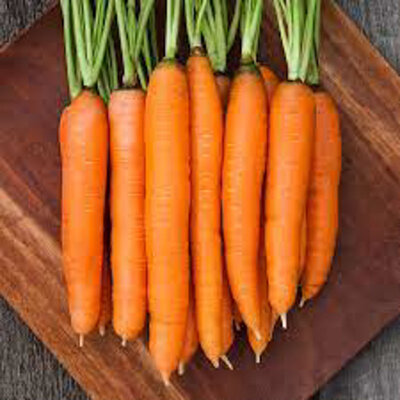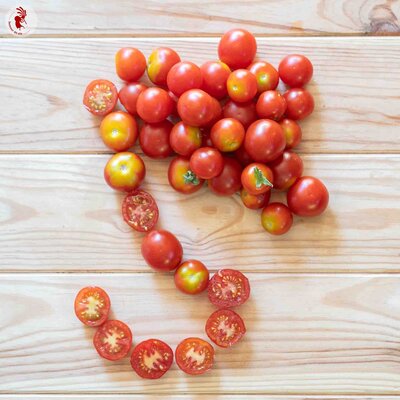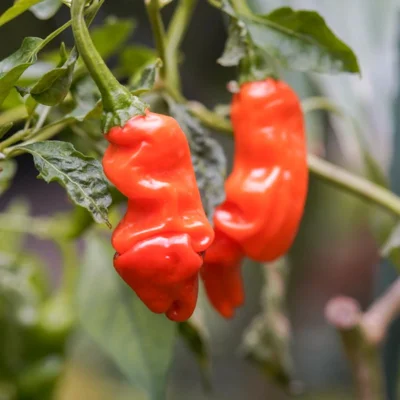
Dolciva (Improved Nantaise) - Orange Carrot
This variety produces smooth, cylindrical, thick roots. Their orange skin contains little heart. They keep very well over winter.
Characteristics of the improved Nantaise Dolciva carrot
Dolciva carrot, Daucus carota, is an improved Nantaise variety bred by Sativa Rheinau, Switzerland, for the Kultursaat association. Its orange, cylindrical roots, 20 to 30 cm long, contain sweet, reddish-orange flesh. This carrot can be eaten grated raw or cooked to accompany meat and fish dishes.
This variety is known for its excellent shelf life and frost resistance.
When to sow the improved Nantaise carrot?
Dolciva improved Nantaise carrot can be sown directly in the ground, from February to July. Choose a sunny spot for planting, and favour rich, well-drained soil that stays cool.
- Sow carrot seeds in the vegetable garden, in rows 25 cm apart. Cover with a thin layer of soil and lightly plumb. Emergence takes place 6 to 21 days after sowing, at temperatures between 10 and 24°C. Keep substrate moist until carrot seeds germinate;
- When plants have 3 leaves, thin to 5 cm, then a few weeks later, to 8 cm. Protect young shoots from slugs if possible;
- Water regularly in the month following sowing to encourage good root development;
- Mulch the soil to keep the carrots cool.
Be careful during the first three weeks of root development: compressed soil and the presence of stones may deform the carrot as it matures.
What companion plants should I grow with carrots?
Carrots keep onion flies away, and onions keep carrot flies away (while protecting them from mildew). Certain perennial and aromatic plants such as rosemary, sage, mugwort and scorzonera also mitigate carrot fly infestations. But the root vegetable also thrives alongside lettuce, tomatoes, radishes, peas, beans, leeks, spring onions and chives. What's more, carrots, like other plants in the Apiaceae family, attract many beneficial insects to the garden.
When to harvest the improved Nantaise carrot?
Dolciva improved Nantaise carrots are harvested from June to November, around 130 days after sowing.
To store, allow the carrots to dry for a few days before cutting off the tops a few centimetres above the collar, then wipe dry and store in a sheltered place such as a gauge, silo or cellar. They can also be stored in the ground in the vegetable garden. Cover them with a good layer of straw or leaves, at least 20 to 25 cm high, to protect them from frost. Carrots also keep well grated and lacto-fermented.
How to eat improved Nantaise carrots?
Rich in fiber and vitamins A, B6 and K, carrots promote healing and regeneration, and regulate intestinal transit. Carrots are 90% water, making them ideal for juices and syrups.
In the kitchen, carrots come in a variety of forms. Raw, it can be grated. Cooked, it can be simmered, roasted, pan-fried or steamed.
These products may also be of interest to you
in the ground
Sow in rows 25 cm apart. Pack lightly. Thin to 5 cm, then to 10 cm when plants are 10 cm tall. If possible, protect young shoots from slugs. Sow in February and March in tunnels or trays, staggering sowing every 2 to 3 weeks to spread out the harvest.
Water regularly, but lightly, to encourage emergence, then more abundantly once a week the month after sowing to prevent the roots from "digging in". Carrots can be harvested all year round if the soil does not freeze or if it is protected by mulch.
March, April, May, June, July
June, July, August, September, October, November
in the ground, in the greenhouse
sunny, semi-shade
medium
all floor types
drained, furniture, rich
Daucus carota
mid-season
From 50 to 150 g
4 grams
elongated
farm
Orange
From 20 to 30 cm
France
This ancient variety was featured in Vilmorin-Andrieux's "Les Plantes Potagères". There are now many varieties under this name. Nantaises were first listed in 1862.











